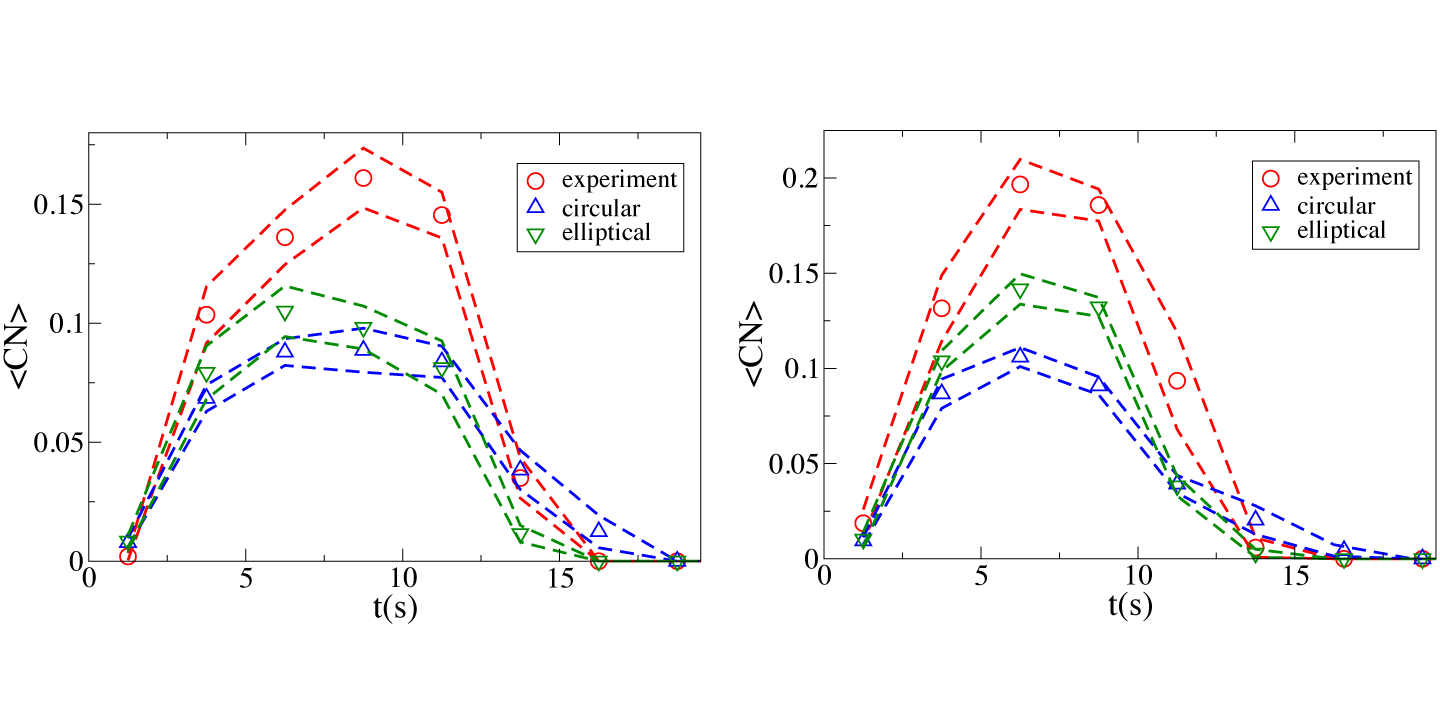Congestion Number Analysis of Cross-Flow Dynamics: Experimental Data and Simulations
DOI:
https://doi.org/10.17815/CD.2024.153Keywords:
Pedestrian cross-flows, Model-data comparison, Crowd evacuation metricsAbstract
We recently proposed the "Congestion Number" (CN) as a metric
to evaluate the state of a pedestrian crowd. Such metric, whose definition is based on the gradient of the rotor of the crowd velocity field, appears to provide additional information with respect to traditional metrics based on pedestrian density and flow.
We also published two works on the dynamics of orthogonally crossing pedestrian flows under different density regimes. In the first manuscript we analysed experimental data by using traditional
observables such as density, velocity and relative position between pedestrians, along with less explored ones such as body orientation. In the second one we proposed a hierarchy of simulation models to reproduce the cross-flow dynamics, and used the aforementioned observables to compare such models.
Based on theoretical considerations and analysis of real world data, we believe the crossing flow setting to be a good arena to test the CN metric, and in this work we perform a CN analysis on the empirical and simulation data. Results show that simulation models, which reproduced almost perfectly the density time dependence of the pedestrian crowd, fail to reproduce the CN one. Actually, models "outperform" the pedestrian crowd when analysed using CN. These preliminary results suggest that the CN metric may provide useful information not only in crowd assessment but also in model evaluation.
References
Elliott, D., Smith, D.: Football stadia disasters in the United Kingdom: learning from tragedy? Industrial & Environmental Crisis Quarterly 7(3), 205-229 (1993). doi:10.1177/108602669300700304
VendelØ, M.T.: The past, present and future of event safety research. In: A Research Agenda for Event Management. Edward Elgar Publishing (2019). doi:10.4337/9781788114363.00010
Rogsch, C., Schreckenberg, M., Tribble, E., Klingsch, W., Kretz, T.: Was it panic? An overview about mass-emergencies and their origins all over the world for recent years. In: Pedestrian and Evacuation Dynamics 2008, pp. 743-755. Springer (2010). doi:10.1007/978-3-642-04504-2_72
Illiyas, F.T., Mani, S.K., Pradeepkumar, A., Mohan, K.: Human stampedes during religious festivals: A comparative review of mass gathering emergencies in India. International Journal of Disaster Risk Reduction 5, 10-18 (2013). doi:10.1016/j.ijdrr.2013.09.003
Lam, W.H., Cheung, C.Y.: Pedestrian speed/flow relationships for walking facilities in Hong Kong. Journal of Transportation Engineering 126(4), 343-349 (2000). doi:10.1061/(ASCE)0733-947X(2000)126:4(343)
Munirajulu, M.: Autodesk CFD for Fire and Smoke Simulation in Buildings (2018). URL https://www.autodesk.com/autodesk-university/class/Autodesk-CFD-Fire-and-Smoke-Simulation-Buildings-2018
Lovreglio, R., Ronchi, E., Kinsey, M.J.: An online survey of pedestrian evacuation model usage and users. Fire Technology pp. 1-21 (2019). doi:10.1007/s10694-019-00923-8
Brščić, D., Kanda, T., Ikeda, T., Miyashita, T.: Person tracking in large public spaces using 3-D range sensors. IEEE Transactions on Human-Machine Systems 43(6), 522-534 (2013)
Corbetta, A., Bruno, L., Muntean, A., Toschi, F.: High statistics measurements of pedestrian dynamics. Transportation Research Procedia 2, 96-104 (2014)
Zanlungo, F., Brščić, D., Kanda, T.: Spatial-size scaling of pedestrian groups under growing density conditions. Physical Review E 91(6), 062810 (2015)
Corbetta, A., Meeusen, J.A., Lee, C.M., Benzi, R., Toschi, F.: Physics-based modeling and data representation of pairwise interactions among pedestrians. Physical Review E 98(6), 062310 (2018)
Fruin, J.J.: Pedestrian planning and design. Elevator Books (1971)
Seyfried, A., Steffen, B., Klingsch, W., Boltes, M.: The fundamental diagram of pedestrian movement revisited. Journal of Statistical Mechanics: Theory and Experiment 2005(10), P10002 (2005)
Mullick, P., Fontaine, S., Appert-Rolland, C., Olivier, A.H., Warren, W.H., Pettré, J.: Analysis of emergent patterns in crossing flows of pedestrians reveals an invariant of ‘stripe’formation in human data. PLoS Computational Biology 18(6), e1010210 (2022)
Zanlungo, F., Feliciani, C., Yücel, Z., Jia, X., Nishinari, K., Kanda, T.: A pure number to assess “congestion” in pedestrian crowds. Transportation Research Part C: Emerging Technologies 148, 104041 (2023)
Cordes, J., Schadschneider, A., Nicolas, A.: Dimensionless numbers reveal distinct regimes in the structure and dynamics of pedestrian crowds. PNAS Nexus (2024). URL https://doi.org/10.1093/pnasnexus/pgae120
Zanlungo, F., Feliciani, C., Yücel, Z., Nishinari, K., Kanda, T.: Macroscopic and microscopic dynamics of a pedestrian cross-flow: Part I, experimental analysis. Safety Science 158, 105953 (2023)
Zanlungo, F., Feliciani, C., Yücel, Z., Nishinari, K., Kanda, T.: Macroscopic and microscopic dynamics of a pedestrian cross-flow: Part II, modelling. Safety Science 158, 105969 (2023)
Feliciani, C., Nishinari, K.: Measurement of congestion and intrinsic risk in pedestrian crowds. Transportation Research Part C: Emerging Technologies 91, 124-155 (2018). doi:10.1016/j.trc.2018.03.027
Boltes, M., Seyfried, A., Steffen, B., Schadschneider, A.: Automatic extraction of pedestrian trajectories from video recordings. In: Pedestrian and Evacuation Dynamics 2008, pp. 43-54. Springer (2010). doi:10.1007/978-3-642-04504-2_3
Boltes, M., Seyfried, A.: Collecting pedestrian trajectories. Neurocomputing 100, 127-133 (2013). doi:10.1016/j.neucom.2012.01.036
Zanlungo, F., Ikeda, T., Kanda, T.: Social force model with explicit collision prediction. EPL (Europhysics Letters) 93(6), 68005 (2011)

Downloads
Published
How to Cite
Issue
Section
Categories
License
Copyright (c) 2024 Francesco Zanlungo, Zeynep Yucel, Claudio Feliciani, Katsuhiro Nishinari, Takayuki Kanda

This work is licensed under a Creative Commons Attribution 4.0 International License.
Authors contributing to Collective Dynamics agree to publish their articles under the Creative Commons Attribution 4.0 license.
This license allows:
Share — copy and redistribute the material in any medium or format
Adapt — remix, transform, and build upon the material
for any purpose, even commercially.
The licensor cannot revoke these freedoms as long as you follow the license terms.
Authors retain copyright of their work. They are permitted and encouraged to post items submitted to Collective Dynamics on personal or institutional websites and repositories, prior to and after publication (while providing the bibliographic details of that publication).








